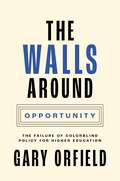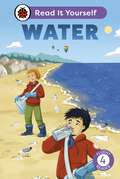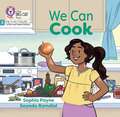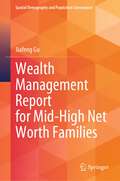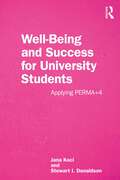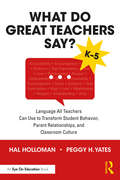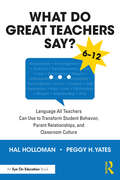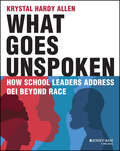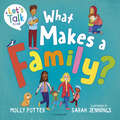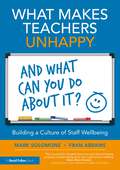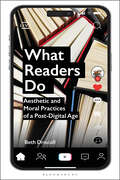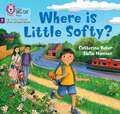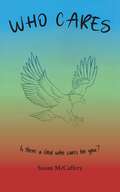- Table View
- List View
The Walls around Opportunity: The Failure of Colorblind Policy for Higher Education (Our Compelling Interests #8)
by Gary OrfieldThe case for race-conscious education policyIn our unequal society, families of color fully share the dream of college but their children often attend schools that do not prepare them, and the higher education system gives the best opportunities to the most privileged. Students of color hope for college but often face a dead end.For many young people, racial inequality puts them at a disadvantage from early childhood. The Walls around Opportunity argues that colorblind policies have made college inaccessible to a large share of students of color, and reveals how policies that acknowledge racial inequalities and set racial equality goals can succeed where colorblindness has failed.Gary Orfield paints a troubling portrait of American higher education, explaining how profound racial gaps imbedded in virtually every stage of our children&’s lives pose a major threat to communities of color and the nation. He describes how the 1960s and early 1970s was the only period in history to witness sustained efforts at racial equity in higher education, and how the Reagan era ushered in today&’s colorblind policies, which ignore the realities of color inequality. Orfield shows how this misguided policy has resegregated public schools, exacerbated inequalities in college preparation, denied needed financial aid to families, and led to huge price increases over decades that have seen little real gain in income for most Americans.Now with a new afterword that discusses the 2023 Supreme Court decision to outlaw affirmative action in college admissions, this timely and urgent book shows that the court&’s colorblind ruling is unworkable in a society where every aspect of opportunity and preparation is linked to race, and reveals the gaps in the opportunity pipeline while exploring the best ways to address them in light of this decision.
Water: Read It Yourself - Level 4 Fluent Reader (Read It Yourself)
by LadybirdHumans, animals, and plants need water every day to survive. But where does it come from? How do we know if it is safe to drink? Learn all about how water is saved, cleaned, and shared in this fact-filled book. Water is from Fluent Reader Level 4 and is ideal for more fluent readers aged from 7+ who are starting to read independently.Each book has been carefully checked by educational and subject consultants and includes comprehension puzzles, book band information, and tips for helping children with their reading. With five levels to take children from first phonics to fluent reading and a wide range of different stories and topics for every interest, Read It Yourself helps children build their confidence and begin reading for pleasure.
We Can Cook: Phase 3 Set 2 (Big Cat Phonics For Little Wandle Letters And Sounds Revised Ser.)
by Sophia Payne Sayada Ramdial Collins Big CatWeak Utopianism in Education: From Political Theory to Pedagogical Practice (Rethinking Education)
by Michael P. MurphyIn the light of the structural dangers of revolutionary change highlighted in the political theory of Giorgio Agamben, this book joins a lively debate in philosophy of education on weak utopianism as an approach that foregrounds and respects the educational potentiality of teachers and students. Utopian moves in education call for revolutionary changes in pedagogical practice in pursuit of a particular vision of the good. Whether grounded in emancipatory politics, technological enthusiasm, or another social movement, utopian moves are seductive in their promise of a better alternative. Weak Utopianism in Education draws together philosophy of education, political theory, scholarship of teaching and learning research, and utopian thought to advocate for a modest and humble approach to change. The theoretical foundation of weak utopianism opens space for educator’s personal convictions and teaching philosophies to tinker with their own pedagogical practices. The book creates a common conceptual meeting ground for philosophers and practitioners in education.
Weak Utopianism in Education: From Political Theory to Pedagogical Practice (Rethinking Education)
by Michael P. MurphyIn the light of the structural dangers of revolutionary change highlighted in the political theory of Giorgio Agamben, this book joins a lively debate in philosophy of education on weak utopianism as an approach that foregrounds and respects the educational potentiality of teachers and students. Utopian moves in education call for revolutionary changes in pedagogical practice in pursuit of a particular vision of the good. Whether grounded in emancipatory politics, technological enthusiasm, or another social movement, utopian moves are seductive in their promise of a better alternative. Weak Utopianism in Education draws together philosophy of education, political theory, scholarship of teaching and learning research, and utopian thought to advocate for a modest and humble approach to change. The theoretical foundation of weak utopianism opens space for educator’s personal convictions and teaching philosophies to tinker with their own pedagogical practices. The book creates a common conceptual meeting ground for philosophers and practitioners in education.
Wealth Management Report for Mid-High Net Worth Families (Spatial Demography and Population Governance)
by Jiafeng GuThis book analyzes the wealth management of mid-high net worth individuals and families. As China's economy develops and people's living standards improve, more and more families are becoming well-off and the middle-income group continues to expand. After creating wealth and becoming rich, better guarding, spreading and enjoying wealth is not only an urgent challenge faced by more and more micro-families, but also an inevitable need to enrich and energize people's livelihood and the connotation of a good life.Mid-high net worth people are an organic part of China's middle-income group, as well as the future coordinates of many families that have just crossed into the middle-income group. An accurate portrait of this group and an in-depth study of the needs, habits, ways and effects of their family wealth management and distribution are conducive to better responding to the demands of affluent families to "keep, pass on and enjoy wealth," as well as exploring the path of solidly promoting common prosperity at the micro-family level. From this perspective, Institute of Social Science Survey of Peking University has conducted a panoramic analysis on mid-high net worth people from panel survey with more 16,000 households in China after 10 years of tracking and investigation, from six aspects: behavioral patterns, financial asset allocation, non-financial asset allocation, commercial insurance allocation, children's commercial medical insurance allocation and pension insurance allocation, the importance of which is self-evident. As the first systematic work on asset allocation and insurance protection of Chinese middle and high net worth families, although part of the purpose is to explore the demand for insurance protection and develop the commercial insurance market, there is no doubt that this study is an important reference for the government to formulate social security policies and for financial institutions to optimize the supply of family wealth services.
Well-Being and Success For University Students: Applying PERMA+4
by Jana Koci Stewart I. DonaldsonWell-Being and Success for University Students: Applying PERMA+4 is grounded in the science of well-being and positive psychology and teaches students how to strengthen their health and well-being, as well as to make their study journey more enjoyable and successful. Higher education has changed dramatically during the last few years, and given the massive growth of mental health challenges among students, universities and faculty have recognized the need to help students to strive, not only survive. Universities have a great potential and responsibility to promote the well-being of their students. This book provides students with information, motivation, and skills to build their own unique well-being and helps colleges to produce more well-being in the university culture. Students and faculty will be introduced to PERMA+4, an evidence-based framework for enhancing well-being and positive functioning, including academic performance. This book emphasizes practical applications of findings from the best available research to have students learn several steps they can take to strengthen their well-being and academic performance. Individual chapters talk about popular topics of positive psychology such as positive emotions, engagement, relationships, meaning, achievement, physical health, mindset, environment, and economic security. Each chapter summarizes the knowledge on specific topics, invites students to assess their well-being in the particular life domain, and encourages them to explore and try activities and evidence-based interventions to learn how to care for their own mental and overall health. This book not only serves as a guide for students but also as a useful tool for professors seeking to enhance their courses and programs with well-being promotion and student wellness centers across the world.
Well-Being and Success For University Students: Applying PERMA+4
by Jana Koci Stewart I. DonaldsonWell-Being and Success for University Students: Applying PERMA+4 is grounded in the science of well-being and positive psychology and teaches students how to strengthen their health and well-being, as well as to make their study journey more enjoyable and successful. Higher education has changed dramatically during the last few years, and given the massive growth of mental health challenges among students, universities and faculty have recognized the need to help students to strive, not only survive. Universities have a great potential and responsibility to promote the well-being of their students. This book provides students with information, motivation, and skills to build their own unique well-being and helps colleges to produce more well-being in the university culture. Students and faculty will be introduced to PERMA+4, an evidence-based framework for enhancing well-being and positive functioning, including academic performance. This book emphasizes practical applications of findings from the best available research to have students learn several steps they can take to strengthen their well-being and academic performance. Individual chapters talk about popular topics of positive psychology such as positive emotions, engagement, relationships, meaning, achievement, physical health, mindset, environment, and economic security. Each chapter summarizes the knowledge on specific topics, invites students to assess their well-being in the particular life domain, and encourages them to explore and try activities and evidence-based interventions to learn how to care for their own mental and overall health. This book not only serves as a guide for students but also as a useful tool for professors seeking to enhance their courses and programs with well-being promotion and student wellness centers across the world.
What Do Great Teachers Say?: Language All Teachers Can Use to Transform Student Behavior, Parent Relationships, and Classroom Culture K-5
by Hal Holloman Peggy H. YatesDo you remember a time when you used the right words at the right moment, and they made all the difference? With the aim of helping you repeat that experience every day, this book provides hundreds of examples of what we call Great Teacher Language, a technique designed to help all teachers use words to transform student behavior and parent relationships. In their years of working at the K-12 levels, educators Hal Holloman and Peggy H. Yates have identified the exact phrases and key words you can use in your classroom to address inappropriate outbursts, a lack of respect and cooperation, student conflict, and more. Great Teacher Language will enable you to transform student behavior, parent relationships, and your classroom culture. This book features 11 Great Teacher Language Word Categories, which you'll learn how to use in terms of self-talk, student talk, and parent talk: Words of Accountability, Words of Encouragement, Words of Grace, Words of Guidance, Words of High Expectations, Words of Hope, Words of Love, Words of Relationships, Words of Respect, Words of Understanding, and Words of Unity. Filled with helpful charts and Great Teacher Language examples, this resource will be one you turn to again and again, and will make a transformational difference for your students, your parents, and you!
What Do Great Teachers Say?: Language All Teachers Can Use to Transform Student Behavior, Parent Relationships, and Classroom Culture K-5
by Hal Holloman Peggy H. YatesDo you remember a time when you used the right words at the right moment, and they made all the difference? With the aim of helping you repeat that experience every day, this book provides hundreds of examples of what we call Great Teacher Language, a technique designed to help all teachers use words to transform student behavior and parent relationships. In their years of working at the K-12 levels, educators Hal Holloman and Peggy H. Yates have identified the exact phrases and key words you can use in your classroom to address inappropriate outbursts, a lack of respect and cooperation, student conflict, and more. Great Teacher Language will enable you to transform student behavior, parent relationships, and your classroom culture. This book features 11 Great Teacher Language Word Categories, which you'll learn how to use in terms of self-talk, student talk, and parent talk: Words of Accountability, Words of Encouragement, Words of Grace, Words of Guidance, Words of High Expectations, Words of Hope, Words of Love, Words of Relationships, Words of Respect, Words of Understanding, and Words of Unity. Filled with helpful charts and Great Teacher Language examples, this resource will be one you turn to again and again, and will make a transformational difference for your students, your parents, and you!
What Do Great Teachers Say?: Language All Teachers Can Use to Transform Student Behavior, Parent Relationships, and Classroom Culture 6-12
by Hal Holloman Peggy H. YatesDo you remember a time when you used the right words at the right moment, and they made all the difference? With the aim of helping you repeat that experience every day, this book provides hundreds of examples of what we call Great Teacher Language, a technique designed to help all teachers use words to transform student behavior and parent relationships. In their years of working at the K-12 levels, educators Hal Holloman and Peggy H. Yates have identified the exact phrases and key words you can use in your classroom to address inappropriate outbursts, a lack of respect and cooperation, student conflict, and more. Great Teacher Language will enable you to transform student behavior, parent relationships, and your classroom culture.The book features 11 Great Teacher Language Word Categories, which you'll learn how to use in terms of self-talk, student talk, and parent talk: Words of Accountability, Words of Encouragement, Words of Grace, Words of Guidance, Words of High Expectations, Words of Hope, Words of Love, Words of Relationships, Words of Respect, Words of Understanding, and Words of Unity.Filled with helpful charts and Great Teacher Language examples, this resource will be one you turn to again and again and will make a transformational difference for your middle and high school students, their parents, and you!
What Do Great Teachers Say?: Language All Teachers Can Use to Transform Student Behavior, Parent Relationships, and Classroom Culture 6-12
by Hal Holloman Peggy H. YatesDo you remember a time when you used the right words at the right moment, and they made all the difference? With the aim of helping you repeat that experience every day, this book provides hundreds of examples of what we call Great Teacher Language, a technique designed to help all teachers use words to transform student behavior and parent relationships. In their years of working at the K-12 levels, educators Hal Holloman and Peggy H. Yates have identified the exact phrases and key words you can use in your classroom to address inappropriate outbursts, a lack of respect and cooperation, student conflict, and more. Great Teacher Language will enable you to transform student behavior, parent relationships, and your classroom culture.The book features 11 Great Teacher Language Word Categories, which you'll learn how to use in terms of self-talk, student talk, and parent talk: Words of Accountability, Words of Encouragement, Words of Grace, Words of Guidance, Words of High Expectations, Words of Hope, Words of Love, Words of Relationships, Words of Respect, Words of Understanding, and Words of Unity.Filled with helpful charts and Great Teacher Language examples, this resource will be one you turn to again and again and will make a transformational difference for your middle and high school students, their parents, and you!
What Goes Unspoken: How School Leaders Address DEI Beyond Race
by Krystal Hardy AllenPractical ways and tools for school leaders to operationalize diversity, equity, and inclusion What Goes Unspoken is a must-have guide for any school or educational systems leader looking to comprehend and put into play an effective, equity-centered plan that champions students, teachers, and staff. Moving beyond the abundant resources that focus on DEI theories, author Krystal Hardy Allen shows leaders and administrators how to concretely center DEI within both practices and policies, as well as how to do the interpersonal work of becoming a self-aware and equity-focused leader. With these resources, you'll learn how to ensure that DEI is embedded in your strategic planning to create schools and education organizations that are transformative, inclusive, and equitable for both children and adults. Focusing on ten specific domains of school leadership and district operations—including school board governance, finance, community engagement, instruction, school culture, and more—this book shows you exactly how to shift from theory to action. Instead of investing thousands of dollars in trainings and initiatives that are often piecemeal, abstract, or at times ineffective, it's essential that that leaders learn practical steps to advance diversity, equity, and inclusion at the district, school, and classroom levels. Drawing on her own school leadership and international educational consultant experience, Allen teaches you to: Better understand your role as a leader within your school or district's DEI work and how the intrapersonal work you do influences your decisions Prioritize an equity-informed view, policies, and practices within different areas of teacher development, school operations and finance, parent engagement, student culture, school board governance, marketing and branding, and more Clarify the relationship between DEI and your schools' or district's mission, vision, values, and goals Build an effective strategic plan at the school or district level that provides both guidance and accountability to your school or district's DEI journey In the current cultural and sociopolitical climate, What Goes Unspoken is a must-read for leaders and administrators of public and private schools, as well as district personnel and educational leadership training programs.
What Goes Unspoken: How School Leaders Address DEI Beyond Race
by Krystal Hardy AllenPractical ways and tools for school leaders to operationalize diversity, equity, and inclusion What Goes Unspoken is a must-have guide for any school or educational systems leader looking to comprehend and put into play an effective, equity-centered plan that champions students, teachers, and staff. Moving beyond the abundant resources that focus on DEI theories, author Krystal Hardy Allen shows leaders and administrators how to concretely center DEI within both practices and policies, as well as how to do the interpersonal work of becoming a self-aware and equity-focused leader. With these resources, you'll learn how to ensure that DEI is embedded in your strategic planning to create schools and education organizations that are transformative, inclusive, and equitable for both children and adults. Focusing on ten specific domains of school leadership and district operations—including school board governance, finance, community engagement, instruction, school culture, and more—this book shows you exactly how to shift from theory to action. Instead of investing thousands of dollars in trainings and initiatives that are often piecemeal, abstract, or at times ineffective, it's essential that that leaders learn practical steps to advance diversity, equity, and inclusion at the district, school, and classroom levels. Drawing on her own school leadership and international educational consultant experience, Allen teaches you to: Better understand your role as a leader within your school or district's DEI work and how the intrapersonal work you do influences your decisions Prioritize an equity-informed view, policies, and practices within different areas of teacher development, school operations and finance, parent engagement, student culture, school board governance, marketing and branding, and more Clarify the relationship between DEI and your schools' or district's mission, vision, values, and goals Build an effective strategic plan at the school or district level that provides both guidance and accountability to your school or district's DEI journey In the current cultural and sociopolitical climate, What Goes Unspoken is a must-read for leaders and administrators of public and private schools, as well as district personnel and educational leadership training programs.
What Makes a Family?: A Let’s Talk picture book to help young children understand different types of families (Let's Talk)
by Molly PotterFrom the bestselling author of How Are You Feeling Today?, this picture book helps children understand and celebrate different types of families.What Makes a Family? explores different types of families, from what makes them unique to what they all have in common. Using everyday examples, clear explanations and colourful illustrations by Sarah Jennings, this book encourages children to celebrate families of all shapes and sizes. This diverse picture book covers lots of different family structures, including nuclear families, blended families, LGBTQ+ families, single-parent families, fostering and adoption. It's the perfect resource for starting important conversations with children about what different families can look like, and the love that holds them all together.Let's Talk books help you start meaningful conversations with your child. Written by an expert and covering topics like feelings, relationships, diversity and mental health, these comforting picture books support healthy discussion right from the start.
What Makes Teachers Unhappy, and What Can You Do About It? Building a Culture of Staff Wellbeing
by Mark Solomons Fran AbramsMany teachers, support staff and school leaders are tired, stressed and overstretched. And even though this frequently makes the headlines, it isn’t a new problem. In this book, Mark Solomons and Fran Abrams argue staff wellbeing should be rooted in the culture and climate of our schools. They provide a roadmap to recovery for struggling schools which should lead to improvements in staff morale, workload management and mental wellbeing. With a range of real-life examples, this book focuses on how school leaders can build workplace wellbeing in even the most challenging environments. It includes clear links to research evidence and summaries of the key steps necessary to deal with common issues such as: Identifying and mapping issues in your school Leading for wellbeing Creating and maintaining a happy workforce Developing a culture of everyday wellbeing Overseeing change. Written in an entertaining yet informative manner, this is the go-to guide for school leaders who want to support staff by building a more positive and supportive workplace.
What Makes Teachers Unhappy, and What Can You Do About It? Building a Culture of Staff Wellbeing
by Mark Solomons Fran AbramsMany teachers, support staff and school leaders are tired, stressed and overstretched. And even though this frequently makes the headlines, it isn’t a new problem. In this book, Mark Solomons and Fran Abrams argue staff wellbeing should be rooted in the culture and climate of our schools. They provide a roadmap to recovery for struggling schools which should lead to improvements in staff morale, workload management and mental wellbeing. With a range of real-life examples, this book focuses on how school leaders can build workplace wellbeing in even the most challenging environments. It includes clear links to research evidence and summaries of the key steps necessary to deal with common issues such as: Identifying and mapping issues in your school Leading for wellbeing Creating and maintaining a happy workforce Developing a culture of everyday wellbeing Overseeing change. Written in an entertaining yet informative manner, this is the go-to guide for school leaders who want to support staff by building a more positive and supportive workplace.
What Readers Do: Aesthetic and Moral Practices of a Post-Digital Age
by Dr Beth DriscollShining a spotlight on everyday readers of the 21st century, Beth Driscoll explores how contemporary readers of Anglophone fiction interact with the book industry, digital environments, and each other.We live in an era when book clubs, bibliomemoirs, Bookstagram and BookTok are as valuable to some readers as solitary reading moments. The product of nearly two decades of qualitative research into readers and reading culture, What Readers Do examines reading through three dimensions - aesthetic conduct, moral conduct, and self-care – to show how readers intertwine private and social behaviors, and both reinforce and oppose the structures of capitalism. Analyzing reading as a post-digital practice that is a synthesis of both print and digital modes and on- and offline behaviors, Driscoll presents a methodology for studying readers that connects book history, literary studies, sociology, and actor-network theory. Arguing for the vitality, agency, and creativity of readers, this book sheds light on how we read now - and on how much more readers do than just read.
Wheater's Functional Histology, E-Book: A Text and Colour Atlas
by Geraldine O'Dowd Sarah Bell Sylvia WrightNow in its seventh edition, Wheater's Functional Histology is designed to give students a working knowledge of histology, including the basic histological structures, tissue types and organ systems. You will learn to recognise the microscopic structure of normal human tissues and understand how this relates to function. The book shows you how to apply histology in a clinical context through coverage of common clinical conditions in each chapter. This must-have book is written clearly and concisely, designed for those studying histology for the first time. Packed with a wealth of illustrations and learning aids, it is a must-have for every medical and health science student. Concise and easy to digest text – easy to follow for those new to histology More than 900 high quality histology images and illustrations, plus detailed explanations to support understanding End of chapter review tables summarising important points Self-assessment questions and rationales to support exam preparation Appendix outlining the basics of microscopy and histological staining techniques Basic glossary More clinical correlation boxes More clinical images More questions added
White Folks: Race and Identity in Rural America (ISSN)
by Timothy J. LensmireWhite Folks explores the experiences and stories of eight white people from a small farming community in northern Wisconsin. Drawing on in-depth interviews with Delores, Frank, William, Erin, Robert, Libby, and Stan, as well as on his own experiences growing up in this same rural community, Lensmire creates a portrait of white people that highlights the profound ambivalence that has characterized white thinking and feeling in relation to people of color for at least the last two hundred years. White people’s relations to people of color and their cultures are characterized not just by fear, rejection, and violence, but also by attraction, envy, and desire. There is nothing smooth about the souls of white folks.This second edition of White Folks features a new foreword—by renowned critical whiteness studies scholar David Roediger—that places the book in historical and political context. It also includes an expanded discussion by Lensmire on doing research on race with white people.
White Folks: Race and Identity in Rural America (ISSN)
by Timothy J. LensmireWhite Folks explores the experiences and stories of eight white people from a small farming community in northern Wisconsin. Drawing on in-depth interviews with Delores, Frank, William, Erin, Robert, Libby, and Stan, as well as on his own experiences growing up in this same rural community, Lensmire creates a portrait of white people that highlights the profound ambivalence that has characterized white thinking and feeling in relation to people of color for at least the last two hundred years. White people’s relations to people of color and their cultures are characterized not just by fear, rejection, and violence, but also by attraction, envy, and desire. There is nothing smooth about the souls of white folks.This second edition of White Folks features a new foreword—by renowned critical whiteness studies scholar David Roediger—that places the book in historical and political context. It also includes an expanded discussion by Lensmire on doing research on race with white people.
White Lies: Racism, Education and Critical Race Theory
by David GillbornUnpacking Critical Race Theory (CRT) and exploring why it has become a focus in politics across the US and the UK, White Lies uses CRT to expose the systemic racism that shapes education. It charts the coordinated campaigns – involving think tanks, mainstream media and politicians – that have tried to silence antiracism in the wake of George Floyd's murder and 'Black Lives Matter'.Each chapter is devoted to exposing a key ‘white lie’ by examining the evidence that shows how the interests of white people continue to occupy centre stage and block movement towards a more equitable education for all. Gillborn establishes how the public debates, shaped by misinformation and 'white lies', sustain race inequity and portray antiracism as a threat to freedom and justice. Key controversies are dissected and debunked, including: the extensive and coordinated anti-CRT campaigns in the US and the UK; the use of racial gaslighting to undermine claims to social justice; how multiple forms of intimidation are used to silence antiracist teaching and protest; the inaccurate portrayal of the white working class as race victims; and how cruelty, in policy, aims to unify whites and demonize minorities. By avoiding unnecessary jargon to make complex debates accessible to a wide audience, this book is ideal reading for anyone studying CRT or interested in the topic of contemporary educational equality.
White Lies: Racism, Education and Critical Race Theory
by David GillbornUnpacking Critical Race Theory (CRT) and exploring why it has become a focus in politics across the US and the UK, White Lies uses CRT to expose the systemic racism that shapes education. It charts the coordinated campaigns – involving think tanks, mainstream media and politicians – that have tried to silence antiracism in the wake of George Floyd's murder and 'Black Lives Matter'.Each chapter is devoted to exposing a key ‘white lie’ by examining the evidence that shows how the interests of white people continue to occupy centre stage and block movement towards a more equitable education for all. Gillborn establishes how the public debates, shaped by misinformation and 'white lies', sustain race inequity and portray antiracism as a threat to freedom and justice. Key controversies are dissected and debunked, including: the extensive and coordinated anti-CRT campaigns in the US and the UK; the use of racial gaslighting to undermine claims to social justice; how multiple forms of intimidation are used to silence antiracist teaching and protest; the inaccurate portrayal of the white working class as race victims; and how cruelty, in policy, aims to unify whites and demonize minorities. By avoiding unnecessary jargon to make complex debates accessible to a wide audience, this book is ideal reading for anyone studying CRT or interested in the topic of contemporary educational equality.
WHO CARES: Is there a God who cares for you?
by Susan McCafferyIn thinking about the contents of these books, which I believe God led me to read, then seeking the Lord for inspiration, three booklets grew in quick succession. "The Good News", a testimony of how the Lord has guided me since becoming a "real" Christian. "Where did we go wrong?", how we as Christians and a church have moved far away from God; and "Reformation and the church", about what Christians and the church have neglected and forgotten over the years. To truly know and experienced the full, entirely powerful glory of God, His awesomeness brilliance in appearance and the mighty God, Who performs miracles. In the UK, we have lost and indeed many have never experienced the total magnificence of God and we need to discover this again to fully empower Christians to reveal God to the world. In this book, I have tried to give you a flavour of what the Lord has shown me in the books I've read, and especially in the Bible, God's inspired word to the world, together with the booklets, God inspired me to write. I have called the book "Who Cares" with a subsidiary title "Is there a God who cares for you?" Outlining what I have experienced of God leading me over the 40 years, since I first became a Christian. It has not always been easy, sometimes wondering if God is there, if He is real, but looking back over the years, I realise the answer has to be yes. God is real, because I have met Him and heard from Him. He has guided me in difficult times and healed me of sickness, led me to places I would not have thought to go, brought me to meet some amazing people and on occasions given me a glimpse of His Glory. These things I would like to share with you to encourage you to seek more of God, on your continued walk with Him, so you can have a greater experience of His Majesty but even more, come to know His great love for you. The book is attempting to answer three questions. Firstly "Is there a God who cares?", giving some answers to those who have doubts or disbelieve. And showing through the life of one man, a family then a nation, whom God chose to reveal Himself to, that He exists and has a purpose for him and all mankind. Secondly "a God Who cares for you," in telling of how God has shown in my life how he cares for me, can help you to also know how much God cares for you. Thirdly "How God cares for the people of world, by seeing how the Church began and more specifically how the Church grew in the UK. Finally I try to answer the question "Where have we gone wrong?" and suggested how this might be put right. I used the term Church , because most people have an understanding of what is meant by that, but in fact the word Church is really relating to the people, not building. I pray that as you read this book, it will inspire you and many others to also see the way forward for the Church in the UK, that this nation will again became the people God intended us to be, reaching out to the people of the world with the love God has for us.
